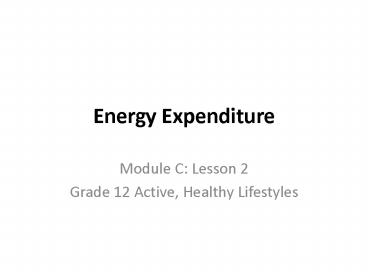Energy Expenditure - PowerPoint PPT Presentation
1 / 12
Title: Energy Expenditure
1
Energy Expenditure
- Module C Lesson 2
- Grade 12 Active, Healthy Lifestyles
2
Energy
- When we consume plant and animal products, the
carbohydrates, fats, and protein are broken down
during digestion, releasing energy and nutrients.
- Some of the energy from these foods is used
immediately for various body functions, and some
is stored as energy to be used at a later time. - The chemical energy provided by food is
ultimately transformed into mechanical energy. - Process of converting food energy into mechanical
work goes on continuously, maintaining the bodys
life-sustaining processes and keeping body
temperature at 37?C. - When we exercise, we use the energy in food to
make the muscles contract - Not perfectly efficient in converting energy into
work, also create heat. - Energy is measured in units called calories.
- Most of the food we eat contains energy
- Everything we do (even sleeping) requires energy,
- The eating patterns described for males and
females of various ages in Canadas Food Guide
are designed to meet the energy requirements, as
well as nutrient needs, of most consumers.
3
(No Transcript)
4
Energy balance
- Refers to the relationship between energy in
(food consumption) and energy out (physical
activity). - Positive balance
- Negative balance
- Storing Fat as Energy
- Historically, the bodys ability to store energy
as fat was extremely useful. - Fat stores are still important today, as they
help us to - Maintain body temperature
- Build and maintain body tissue and cells
- Protect internal organs
- Fuel muscle movement
- Easy to over-consume food and store an excess of
energy and have systematically reduced physical
activity in our daily lives through all the
conveniences available
5
Energy Expenditure
- The human body spends energy for many different
purposes, such as life-sustaining metabolic
functions, digestion, and physical activity. - Basal or resting metabolic rate (BMR or RMR)
- Thermic effect of food (TEF)
- Energy expenditure of activity (EEA)
- Overall Energy Expenditure RMR TEF EEA
- Basal or Resting Metabolic Rate
- Amount of energy per minute the body uses to
maintain a quiet resting state - Approximately 1 Cal per minute (1440 minutes in a
day x 1 Cal/min 1440 Cal per day) - 60 to 75 of the energy used every day is needed
to maintain the essential body functions that
sustain life - BMR measurements
- RMR measurements
6
(No Transcript)
7
Energy Expenditure
- Thermic Effect of Food
- Energy required to process the food we eat
- 10 of the calories in a meal are used to digest,
metabolize, and store the food just eaten - Directly related to the size of the meal and the
food composition - Energy Expenditure of Activity
- Energy needed to fuel body movement as it occurs
in activities of daily living, including
exercise. - Muscle tissue consumes approximately 20 of this
energy at rest, but during vigorous exercise, the
rate of energy consumption by muscle tissue may
go up 50 times or more - Physical activity can have a dramatic impact on a
persons daily energy expenditure - Involuntary movements such as fidgeting and
posture control (called NEAT non-exercise
activity of thermogenesis) also contribute
8
The Cost of Being Sedentary
- The rising rates of obesity are due as much to
reduced energy expenditure as to over-consumption
of calories. - 8- to 18-year-olds the average amount of time
per day spent using media is at least 6 hours and
21 minutes a day - does not include time spent
sitting in class. - More than half the young people ages 5 to 17 are
not active enough for optimal growth and
development - Active enough is equivalent to an energy
expenditure of at least 8 kilocalories per
kilogram of body mass per day. - Canadas Physical Activity Guide for Youth
recommends that young people participate in at
least 90 minutes a day of moderate to vigorous
physical activity. - Moderate physical activity 60 min at 6 Cal/min
360 Cal (approximate) - Vigorous physical activity 30 min at 9 Cal/min
270 Cal (approximate)
9
Energy Expenditure of Physical Activities
- Determining Resting Metabolic Rate (RMR)
- BMR/RMR can be estimated by adding a zero to
body weight in pounds (e.g., for an individual
weighing 140 lbs BMR/RMR is approximately 1400
Cal). - RMR (Female) 248 x m(0.4356) (5.09 x a)
- RMR (Male) 293 x m(0.4330) (5.92 x a)
- Where m body mass in kg a age in years.
- RM 4NU Resting Metabolic Rate (RMR) Calculator
10
(No Transcript)
11
Determining the Energy Expenditure of Various
Physical Activities
- Identify several activities from their physical
activity plan (or other comparable activities)
and locate them in RM 5NU Energy Expenditure of
Physical Activities - If a physical activity is listed more than once,
note the different levels of intensity and select
the level that best reflects participation - Write a journal entry comparing and contrasting
energy expenditure associated with activities at
different levels of intensity
12
Determining Relative Energy Expenditure through
Daily Physical Activity Intensities
- Determine the amount of time spent engaged in
physical activities in various intensity
categories over a three-day period using RM
6NU Determining Daily Physical Activity
Intensities. - First identify the number of hours spent sleeping
(resting), and then the time spent in vigorous or
moderate activity, and finally the time spent in
very light or light activity































